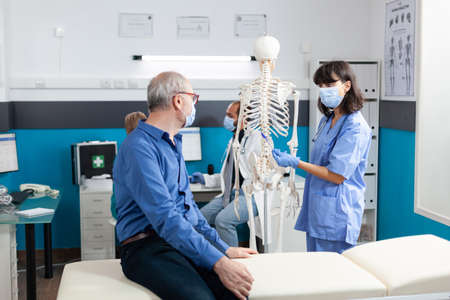Understanding Spinal Fusion Surgery
Spinal fusion surgery is a medical procedure designed to join two or more vertebrae in your spine so that they heal into a single, solid bone. This process helps to stabilize the spine, reduce pain, and improve mobility for people dealing with certain spinal conditions. In the United States, spinal fusion has become a common solution for chronic back problems that havent improved with other treatments.
Overview of Spinal Fusion
The main goal of spinal fusion is to stop movement between the affected vertebrae, which can help relieve symptoms like pain, instability, or nerve irritation. During the surgery, your doctor may use bone grafts—either from your own body or from a donor—to help the bones fuse together. Sometimes, metal plates, screws, or rods are added for extra support.
Common Reasons for Surgery
There are several reasons why someone in the U.S. might need spinal fusion surgery. Here are some of the most common:
| Condition | Description |
|---|---|
| Degenerative Disc Disease | Breakdown of discs causing pain and instability |
| Scoliosis | Abnormal curvature of the spine needing correction |
| Spondylolisthesis | One vertebra slips over another causing nerve issues |
| Spinal Fractures | Broken bones due to injury or osteoporosis |
| Spinal Stenosis | Narrowing of the spinal canal putting pressure on nerves |
What to Expect: The Procedure and Initial Recovery
If you or a loved one is preparing for spinal fusion surgery, it’s normal to feel a bit anxious about what lies ahead. Here’s what you can generally expect during the procedure and early recovery phase:
- Surgery Day: The operation usually takes several hours and is performed under general anesthesia. Depending on your condition, the surgeon may access your spine from the front (anterior), back (posterior), or side (lateral).
- Hospital Stay: Most patients stay in the hospital for 2-4 days after surgery so doctors can monitor their progress and manage pain.
- Pain Management: Pain and discomfort are common initially but are managed with medications and gradual movement as tolerated.
- Early Movement: Physical therapists often visit soon after surgery to guide safe ways to get out of bed, move around, and start gentle exercises.
- Home Preparation: Before heading home, healthcare providers will give instructions on caring for your incision, managing pain at home, and any activity restrictions.
A Quick Look: What Patients Can Expect After Spinal Fusion Surgery
| Timeline | Typical Activities/Expectations |
|---|---|
| First Few Days Post-Surgery | Pain management; short walks with assistance; learning safe movement techniques; beginning gentle exercises guided by physical therapists. |
| First 2-4 Weeks at Home | Gradual increase in activity; avoiding heavy lifting/twisting; following doctor’s instructions for wound care and medication. |
| 1-3 Months After Surgery | Slow return to daily routines; continued rehab exercises; follow-up appointments with your surgical team. |
Please note:
Your specific recovery plan may differ based on your health history and exact procedure type. Always follow your healthcare provider’s recommendations closely for best results.
2. Early Recovery: Post-Operative Care
Key Tips for Immediate Post-Surgical Care
The first few days and weeks after spinal fusion surgery are crucial for a safe and smooth recovery. Following your healthcare provider’s instructions and knowing what to expect can help you stay on track. Here are some essential tips to get you started:
- Follow Medication Instructions: Take your prescribed medications exactly as directed to manage pain and prevent infection.
- Keep Your Incision Clean and Dry: Proper wound care helps avoid infections. Follow your nurse or doctor’s guidelines for showering and dressing changes.
- Move with Care: Use assistive devices like walkers if recommended, and always practice safe movements to protect your spine. Avoid twisting, bending, or lifting anything heavy.
Pain Management Strategies
Pain is common in the early stages of recovery but should improve gradually. Use these strategies to help manage discomfort:
| Pain Management Method | Description |
|---|---|
| Medications | Pain relievers prescribed by your doctor, including opioids (short-term) or over-the-counter meds like acetaminophen. |
| Ice Packs | Apply ice packs to reduce swelling and numb the area (20 minutes on, 20 minutes off). |
| Gentle Movement | Short walks around your home can help circulation and reduce stiffness. |
| Rest & Positioning | Rest when needed, but avoid staying in bed all day. Use pillows for support when sitting or lying down. |
Preventing Common Complications
Avoiding complications is key to a successful recovery. Be alert for signs that may need medical attention:
- Watch for Infection: Redness, swelling, increased pain at the incision site, fever, or drainage should be reported to your doctor right away.
- Avoid Blood Clots: Move your feet and legs often, even while in bed. Wear compression stockings if advised by your medical team.
- Lung Health: Practice deep breathing exercises or use an incentive spirometer to keep your lungs clear after surgery.
Setting Realistic Expectations for Recovery
Your body needs time to heal after spinal fusion surgery. Here’s what you can typically expect during the early recovery period:
| Timeframe After Surgery | What to Expect / What You Can Do |
|---|---|
| First Few Days | Pain and fatigue are normal; begin gentle walking with assistance; focus on wound care and pain management. |
| First 1-2 Weeks | You’ll slowly increase activity levels; still avoid lifting, bending, or twisting; start outpatient physical therapy if approved by your surgeon. |
| Weeks 3-6 | You may notice gradual improvement in strength and mobility; continue following restrictions; attend follow-up appointments. |
Your Recovery Support Team Matters
Your surgeon, nurses, physical therapists, family, and friends are all part of your recovery team. Don’t hesitate to ask questions or let them know how you’re feeling so they can help you every step of the way.

3. Starting Rehabilitation: Physical Therapy Essentials
After spinal fusion surgery, getting started with rehabilitation is a crucial part of your recovery journey. Physical therapy is designed to help you regain movement, build strength, and safely return to your daily activities. Understanding what to expect and following your rehab plan closely can make a big difference in your outcome.
Introduction to Physical Therapy
Your physical therapy will usually begin soon after your surgery, often while you are still in the hospital. The main goal at this stage is to help you move safely and prevent complications like blood clots or muscle stiffness. A licensed physical therapist will guide you through every step, making sure exercises are safe for your specific condition.
Gradual Increase in Movement
It’s important to take things slow and steady. Your therapist will start with gentle movements and gradually increase activity as you heal. This approach helps protect your spine while improving flexibility and reducing pain. Remember, everyone heals at their own pace—don’t compare your progress to others!
Typical Progression Timeline
| Time After Surgery | Rehabilitation Focus |
|---|---|
| Week 1-2 | Gentle bed exercises, walking short distances, learning safe ways to get in/out of bed |
| Week 3-6 | Increasing walking distance, basic stretching, introducing light strengthening exercises |
| Week 7+ | Building core strength, improving balance, more advanced functional activities |
Basic Exercises After Spinal Fusion
Your therapist will teach you simple exercises that support your healing spine. Here are some examples:
- Ankle pumps: Move your feet up and down to keep blood flowing.
- Heel slides: Gently slide your heel toward your buttocks while lying down.
- Pillow squeezes: Squeeze a pillow between your knees to engage hip muscles.
- Short walks: Walk around your home or hospital floor as tolerated.
(Always follow your therapist’s instructions and never try new exercises without approval.)
The Importance of Following Your Rehab Plan
Your rehab plan is tailored just for you. It takes into account the type of fusion surgery you had, your age, lifestyle, and overall health. Sticking with the plan gives you the best chance for a strong recovery. Skipping sessions or doing more than recommended can slow healing or even cause harm. If you have questions or concerns about any part of your rehab process, talk openly with your therapy team—they’re there to help!
4. Lifestyle Adjustments and Safety at Home
After spinal fusion surgery, making the right lifestyle adjustments and setting up your home for safety can help you recover smoothly and protect your spine. Here are some practical recommendations to keep your healing process on track and encourage independence while minimizing the risk of injury.
Home Modifications for a Safer Recovery
Its important to make your living space as safe and accessible as possible during your recovery. Small changes can prevent falls or unnecessary strain on your back.
| Area | Recommended Modification |
|---|---|
| Bathroom | Install grab bars near the toilet and in the shower; use a non-slip mat; consider a raised toilet seat and shower chair. |
| Bedroom | Place frequently used items within easy reach; use a nightstand for medications and water; ensure the bed is at a comfortable height. |
| Living Room | Remove throw rugs and clutter; arrange furniture for clear pathways; use chairs with armrests for easier standing up. |
| Stairs | Add handrails on both sides if possible; keep stairs well-lit and free of obstacles. |
| General | Keep floors dry; secure cords along walls; use night lights to prevent tripping at night. |
Maintaining Spine Precautions at Home
Your doctor will give you specific instructions on how to move safely after surgery. Here are some general tips that often apply:
- Avoid bending, twisting, or lifting heavy objects: Use tools like reachers or grabbers for picking things up from the floor.
- Practice proper body mechanics: Always bend at your knees (not your waist) when picking up light objects. Keep items close to your body when lifting.
- No BLT rule: No Bending, Lifting (over 5-10 pounds), or Twisting until cleared by your physician or physical therapist.
- Sit in supportive chairs: Choose seats with sturdy backs and armrests. Avoid low sofas or recliners that are hard to get out of.
- Log roll technique: When getting in and out of bed, roll onto your side, then push yourself up with your arms while keeping your spine straight.
Promoting Independence While Staying Safe
The goal is to help you do daily activities on your own, but safely. Here are some helpful ideas:
- Dress smart: Wear slip-on shoes and loose-fitting clothes to avoid extra bending or struggling with buttons.
- Cook simply: Prepare meals in advance or use meal delivery services during early recovery. Use lightweight cookware and keep essentials within easy reach.
- Ask for help: Don’t hesitate to ask family, friends, or neighbors for assistance with chores like laundry, grocery shopping, or taking out the trash.
- Pace yourself: Take breaks between tasks and listen to your body’s signals. It’s okay to rest when needed!
- Create a daily routine: Establishing a gentle schedule can help you regain confidence and independence without overexerting yourself.
Your Safety Checklist at Home
| Task | Status (Check/Update) |
|---|---|
| Grab bars installed in bathroom? | |
| Beds/chairs at appropriate height? | |
| No loose rugs/clutter in walkways? | |
| Cords secured along walls? | |
| Essential items within easy reach? | |
| Nonslip mats in bathroom/kitchen? | |
| Adequate lighting in hallways/stairs? | |
| Name/number of emergency contact visible? |
If you have questions about making these changes or want advice tailored to your home setup, talk with your physical therapist—they’re there to support you every step of the way!
5. Long-Term Success: Staying Active and Healthy
Strategies for Returning to Daily Activities
After spinal fusion surgery, getting back to your normal routine is a big milestone. Start slow and listen to your body. At first, focus on simple daily activities like getting dressed, making meals, or going for short walks. Gradually increase your activity level as you feel stronger and more confident. Your physical therapist can guide you on safe ways to move, bend, or lift. Remember, everyone heals at their own pace—there’s no rush.
Tips for Everyday Tasks
| Activity | Helpful Tips |
|---|---|
| Bending Down | Use your knees instead of bending from the waist. Consider using a reacher tool for picking things up. |
| Lifting Objects | Keep objects close to your body and avoid lifting anything heavy until cleared by your doctor. |
| Getting in/out of Bed | Roll onto your side and push up with your arms instead of sitting straight up. |
| Walking | Start with short walks several times a day and increase distance as tolerated. |
Rebuilding Strength After Surgery
Your muscles may feel weaker after surgery, but gentle exercise will help you rebuild strength and improve flexibility. Work with your rehab team to create a plan that fits your needs. Focus on exercises that target your core, legs, and back muscles without putting too much strain on your spine. Simple activities like walking, swimming (once approved), or riding a stationary bike are great ways to stay active.
Sample Weekly Activity Plan
| Day | Activity Example |
|---|---|
| Monday | Short walk outside + gentle stretching |
| Tuesday | Physical therapy session + rest breaks as needed |
| Wednesday | Stationary cycling (if approved) + light core exercises |
| Thursday | Rest day or leisure activity (reading, visiting friends) |
| Friday | Swimming or water aerobics (if approved) |
| Saturday | Walk in the park + family time |
| Sunday | Meditation or mindfulness practice + stretching |
Integrating Into the Community
Connecting with others can make recovery easier and more enjoyable. Look for local support groups for people who have had spinal surgery or chronic back pain. Many communities also offer adaptive sports programs, yoga classes for beginners, or group exercise sessions designed for people with limited mobility. Volunteering or joining hobby clubs are also great ways to stay social while staying active.
Community Resources to Explore
- Parks & Recreation Centers: Check for low-impact fitness classes.
- YMCA/YWCA: Offers pool access and group classes tailored for recovery.
- Local Support Groups: Meet others who understand your journey.
- Libraries: Often host free events, lectures, or social gatherings.
- Seniors’ Centers: Not just for seniors! Many offer inclusive wellness programs.
Staying Motivated for a Successful Outcome
The road to full recovery can be long, but setting small goals helps keep you motivated. Celebrate each victory—whether it’s walking an extra block or cooking dinner on your own. Keep a journal to track progress and setbacks. Share your journey with family and friends so they can cheer you on. If you ever feel stuck or discouraged, talk with your rehab team—they’re there to help you succeed every step of the way!


